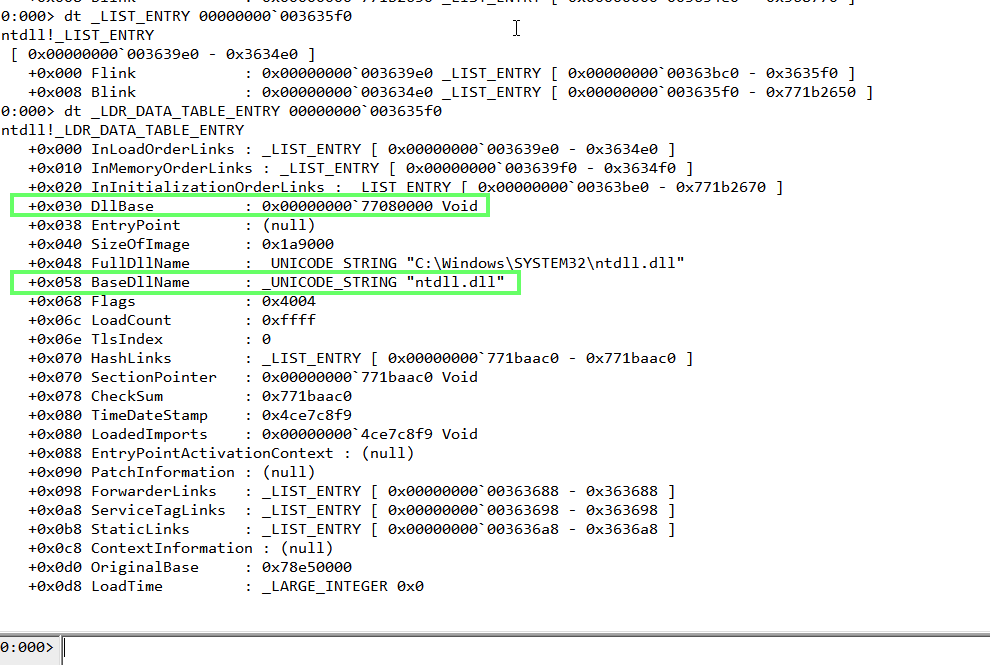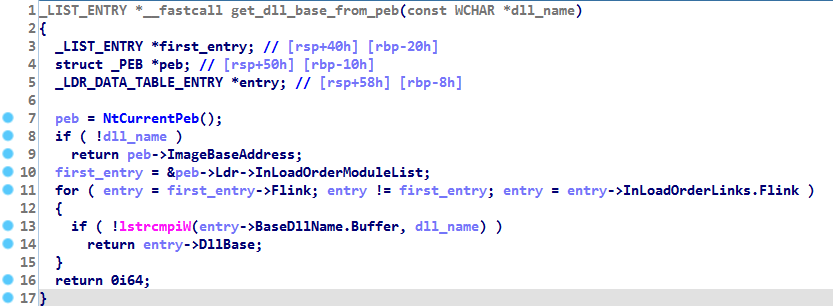How to get a DLL base address from the Process Environment Block (PEB)
Very often, we see malware families dynamically resolving the needed Windows APIs. One of the first steps that many malware families take is to get the base address of either KERNEL32.DLL or NTDLL.DLL from the Process Environment Block (PEB).
The Process Environment Block (PEB) is a structure that contains information about the process itself and the loaded modules.
The following is the official documented PEB structure (MSDN):
typedef struct _PEB {
BYTE Reserved1[2];
BYTE BeingDebugged;
BYTE Reserved2[1];
PVOID Reserved3[2];
PPEB_LDR_DATA Ldr;
PRTL_USER_PROCESS_PARAMETERS ProcessParameters;
PVOID Reserved4[3];
PVOID AtlThunkSListPtr;
PVOID Reserved5;
ULONG Reserved6;
PVOID Reserved7;
ULONG Reserved8;
ULONG AtlThunkSListPtr32;
PVOID Reserved9[45];
BYTE Reserved10[96];
PPS_POST_PROCESS_INIT_ROUTINE PostProcessInitRoutine;
BYTE Reserved11[128];
PVOID Reserved12[1];
ULONG SessionId;
} PEB, *PPEB;
Note: The reserved names are there because Microsoft officially does not document all fields from the PEB structure.
One way of getting the pointer to the PEB is, for example, by accessing a specific offset in the FS or GS register (depends on the architecture).
- FS[0x30] - 32 bit Windows
- GS[0x60] - 64 bit Windows
C code snippet for getting a valid pointer to PEB:
#ifndef _WIN64
PEB* peb = (PEB*) __readfsdword(0x30);
#else
PEB* peb = (PEB*) __readgsqword(0x60);
#endif
After getting access to the PEB pointer, it’s possible to access the Ldr field which, points to a PEB_LDR_DATA structure.
0:000> dt ntdll!_PEB_LDR_DATA
+0x000 Length : Uint4B
+0x004 Initialized : UChar
+0x008 SsHandle : Ptr64 Void
+0x010 InLoadOrderModuleList : _LIST_ENTRY
+0x020 InMemoryOrderModuleList : _LIST_ENTRY
+0x030 InInitializationOrderModuleList : _LIST_ENTRY
+0x040 EntryInProgress : Ptr64 Void
+0x048 ShutdownInProgress : UChar
+0x050 ShutdownThreadId : Ptr64 Void
This structure contains the InLoadOrderModuleList field that points to a LIST_ENTRY.
As seen below, the LIST_ENTRY structure is a double-linked list that contains two pointers. One pointer is for the next LIST_ENTRY, while the other is for the previous one.
0:000> dt ntdll!_LIST_ENTRY
+0x000 Flink : Ptr64 _LIST_ENTRY
+0x008 Blink : Ptr64 _LIST_ENTRY
The trick is that in these LIST_ENTRY pointers there is another structure (a bigger one), which contains more data. This structure is named LDR_DATA_TABLE_ENTRY and below we can see its definition:
0:000> dt ntdll!_LDR_DATA_TABLE_ENTRY
ntdll!_LDR_DATA_TABLE_ENTRY
+0x000 InLoadOrderLinks : _LIST_ENTRY
+0x010 InMemoryOrderLinks : _LIST_ENTRY
+0x020 InInitializationOrderLinks : _LIST_ENTRY
+0x030 DllBase : Ptr64 Void
+0x038 EntryPoint : Ptr64 Void
+0x040 SizeOfImage : Uint4B
+0x048 FullDllName : _UNICODE_STRING
+0x058 BaseDllName : _UNICODE_STRING
+0x068 Flags : Uint4B
+0x06c LoadCount : Uint2B
+0x06e TlsIndex : Uint2B
+0x070 HashLinks : _LIST_ENTRY
+0x070 SectionPointer : Ptr64 Void
+0x078 CheckSum : Uint4B
+0x080 TimeDateStamp : Uint4B
+0x080 LoadedImports : Ptr64 Void
+0x088 EntryPointActivationContext : Ptr64 _ACTIVATION_CONTEXT
+0x090 PatchInformation : Ptr64 Void
+0x098 ForwarderLinks : _LIST_ENTRY
+0x0a8 ServiceTagLinks : _LIST_ENTRY
+0x0b8 StaticLinks : _LIST_ENTRY
+0x0c8 ContextInformation : Ptr64 Void
+0x0d0 OriginalBase : Uint8B
+0x0d8 LoadTime : _LARGE_INTEGER
By casting the LIST_ENTRY pointer as a pointer to the LDR_DATA_TABLE_ENTRY structure, we get access to some fields such as the BaseDllName and the DllBase:

Note: The BaseDllName is in UNICODE.
A snippet of an implementation of this technique as seen by the hex-rays decompiler:
